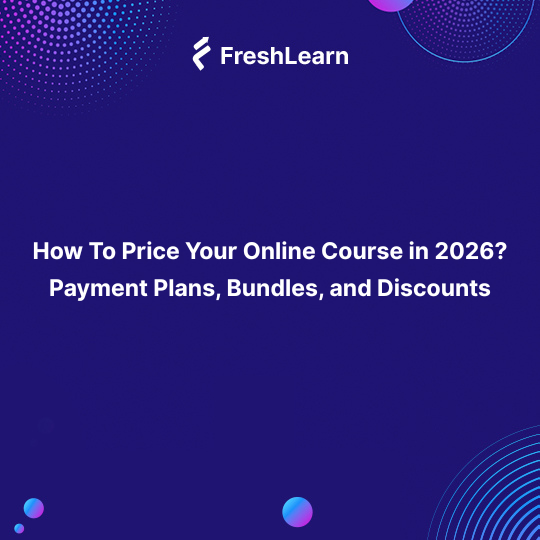
How To Price Your Online Course in 2026? Payment Plans, Bundles, and Discounts
Pricing your online course is harder than creating it.
You know your content is valuable. You spent months developing lessons, recording videos, and building resources. But when it comes time to set a price, the clarity disappears.
For instance, a Reddit user (as shown here) couldn't decide between $199 and $249 because they were afraid of the psychological barrier at $200.
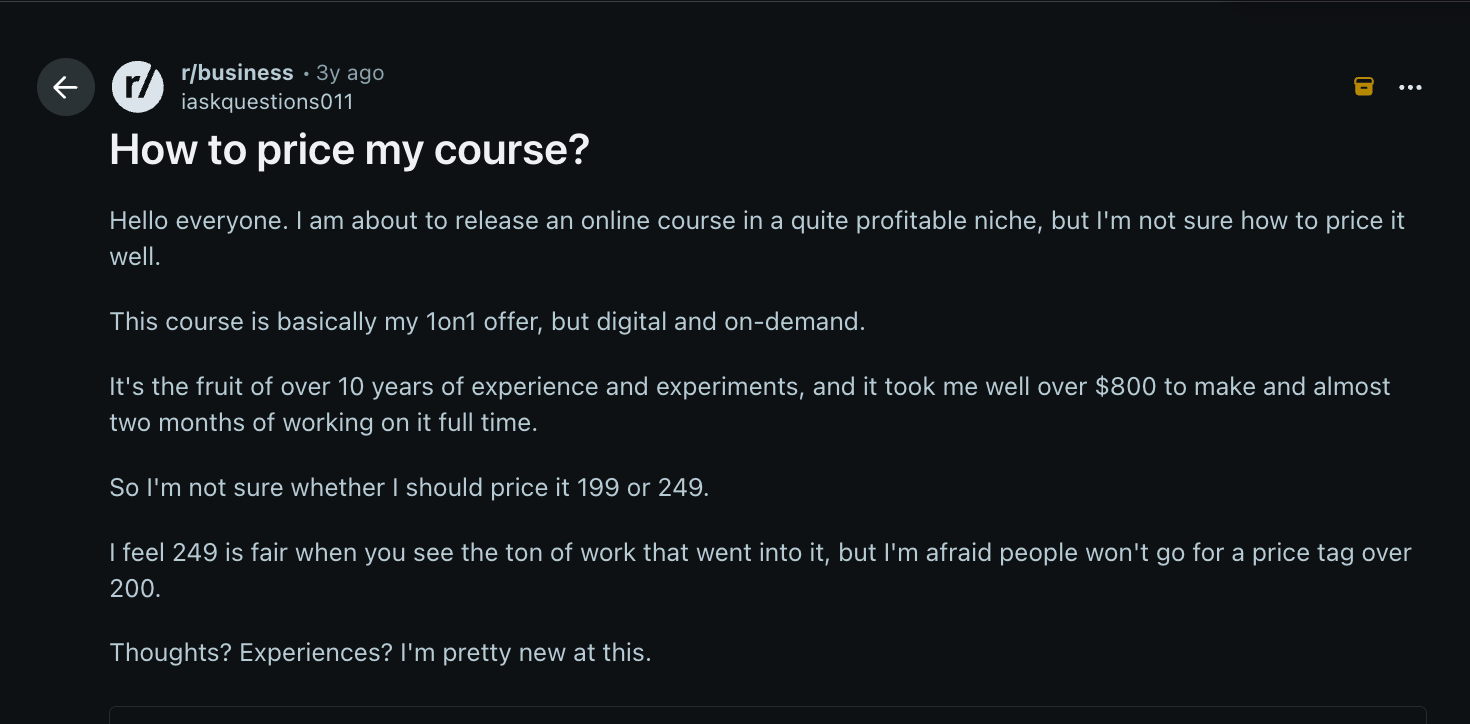
This is the exact confusion most creators face. The problem is not a lack of information but the availability of too much conflicting information. This article will show you exactly how to price your online course with confidence.
You’ll learn how to choose a price that reflects real value, avoids psychological traps, and aligns with what buyers are actually willing to pay, without guessing, underpricing, or copying competitors blindly.
Why Does Pricing Your Course Matter More Than Ever in 2026?
The creator economy is booming and has taken center stage in several business strategies. It’s only to grow bigger, nearly double to $480 billion by 2027, as per the 2023 Creator Economy report of Goldman Sachs.
Your price communicates more than your course content ever will. Online courses are on the rise and will rise even further in the future. The Future of Learning Report 2022 proves this to the T:
- 81% of people who switched their career paths attributed it to an online course
- The same study said that 31% of the surveyed respondents said they would take an online short course to gain new skills to boost their career, and hence, enrolled in short courses.
- 42% said, as per the study, online courses were the best way to acquire new skills for starting a business.
- 30% of people between the ages of 16 and 24 opted to take online short courses to learn new skills.
- 23% of learners preferred online courses to other methods primarily because of the freedom of learning at their own pace, followed by the ability to learn from home (22%) and overall flexibility (20%).
These numbers reinforce the imperative of pricing your online courses well.
Consumer habits are dynamic.
Consumer buying habits have shifted due to the economic climate. In 2026, buyers report good value of the service as the highest determining factor in the purchase decision.
But when the quality of the service and customer satisfaction are what drives the purchase, trust and satisfaction are highest when price is not the sole factor. Therefore, there is no need to undercut competitors as this approach is not economically viable.
Learners have become more value-conscious.
As the price of goods continues to rise, consumers have become very focused on the value of their purchases. Value for money has been identified as the most important factor when the consumer makes a decision to buy. By 2030, one in 16 workers will need to change occupations to meet the changing needs of the labour market.
Courses will play an important role in helping people gain new skills and bridging global skills gaps. On average, almost two-fifths of workers’ core skills will change between 2025 and 2030, keeping constant pressure on people to learn new skills. In fact, 85% of employers plan to prioritize upskilling their workforce in future.
The most popular courses on various online platforms are increasingly reflecting global skills gaps across various industries.
Quality and service will drive the purchasing decision of the consumer. When the consumer focuses on quality and service, the amount of trust and satisfaction increases substantially, compared to just focusing on price when purchasing the product.
Pricing now starts with understanding your learner deeply
Today, guessing what your audience wants is no longer enough. Learner behaviour has become harder to predict. Buying decisions are influenced by far more than price: trust, timing, relevance, and perceived usefulness now play a bigger role than ever.
This means creators must move beyond assumptions and build a clear, data-backed understanding of who their learners are, what they struggle with, and what they are actively searching for.
Pay attention to what people ask in comments. Track what content performs best on your social channels. Read reviews on competing courses, and study objections in sales emails and discovery calls.
The closer you get to real learner behaviour, the easier pricing becomes. You stop guessing. You start positioning.
Pricing is an act of balance, and not a discounting strategy.
Pricing your course is not about being the cheapest. It is about finding the sweet spot where value and affordability meet.
Price it too low, and learners may question the quality, treat it casually, or never complete it. That often leads to low engagement, few testimonials, and weak word-of-mouth.
Price it too high, and you create hesitation before your course even has a chance to prove its value. Potential buyers walk away, not because your course is bad, but because the risk feels too high.
Aim for pricing your online course in a way that learners pursue it seriously and feel confident enough to buy. Don’t compete only on price. Instead, focus on building:
- Clear value through outcomes and positioning
- Trust through quality and consistency
- Reputation through support and learner success
In this way, you stop chasing one-time sales and start building repeat buyers and long-term credibility. Let’s now see how you can price your online courses effectively.
A Step-by-Step Guide to Pricing Your Online Courses
Step 1: Understand your audience’s ability and willingness to pay
To begin with, you need to separate your audience’s “ability to pay” from their “willingness to pay” as these are two different things. This is where many creators falter and end up projecting their own financial fears onto their customers.
Ability to pay is a financial reality. A college student likely has a lower ability to pay than a corporate executive.
Willingness to pay is about value. A corporate executive might have the money. However, they will not pay if they do not see the value. A college student might be broke. However, they will find the money if the course solves an urgent, painful problem.
Do not rely on your intuition. Here’s how you should go about it:
Analyze your competitors
Look at other courses in your niche. What do they charge? This gives you a baseline.
If the market average is $200, you have a reference point. You do not have to match this price, but you can price lower to undercut them. Or, you can price higher to position yourself as the premium option. All you need to know is the range.
Survey your audience
Ask your potential buyers. You can send a simple survey to your email list or post a poll on social media. Instead of asking how much they would pay for your courses, try to understand their challenges.
Ask instead: "What is the biggest problem you are facing right now regarding [Topic]?"
This tells you the pain level. If the problem is costing them money or sleep, they will pay to solve it.
Run the "MVP (minimal viable product)" test
The best data comes from actual sales. Run a pre-sale. Offer a pilot version of the course. Sell it at a lower price before you finish creating all the content.
If people buy, you have validated the price. If not, you have saved yourself months of work. You can then adjust the offer or the price.
Step 2: Choose a pricing model that fits your course
There is no single "correct" model. The right choice depends on your business goals. It depends on the type of content you teach. Below are some examples of pricing models you can choose for your online courses.
You can choose from any of these models as per your requirements and business goals.
Step 3: Use tiered pricing to capture different buyer segments
You leave money on the table when you offer only one price. Always offer tiered pricing.
This is because different people in your audience have different needs. Some people have a small budget. They just want the information. They are happy to watch the videos and do the work alone.
Some learners have a larger budget and are willing to pay for speed, support, and feedback because they want a better overall experience. Tiered pricing allows you to serve both value-conscious learners and those who are happy to invest more for added support and faster outcomes.
How to set up tiered pricing for your online courses?
When setting up tiers, always start with your base offering.
- Begin with a lower-priced tier that includes only the essentials. Your core lessons and foundational resources. This tier exists to make your course accessible and remove hesitation for first-time buyers. It should deliver real value, but without extras.
- Next, introduce a mid-tier for learners who want speed and convenience. Add practical tools like templates, checklists, or pre-built resources that help them implement faster with less effort. This is usually where most buyers will land because it feels like a strong value upgrade for a reasonable jump in price.
- Finally, create a top-tier for learners who want support, feedback, or direct access to you. This tier is not about more content; it is about reducing uncertainty and increasing confidence through guidance. Coaching, community, or one-to-one sessions belong here.
Ensure that each tier clearly answers the “What kind of buyer is this for?” question. Use the table below as an example to understand how such tiers typically work in practice:
In addition, make your higher tier irresistible with utility, not just information. Your higher tiers should not just pile on more videos or lessons. They should offer tools that save time.
Take Refactoring UI by Adam Wathan and Steve Schoger. They teach UI design to developers through a two-tier model.
Their basic tier costs $99. You get a PDF book and three video tutorials. This works for those who want to learn the theory. Their complete package costs $149. You get everything from the basic tier plus a component gallery, font recommendations, and colour palettes.
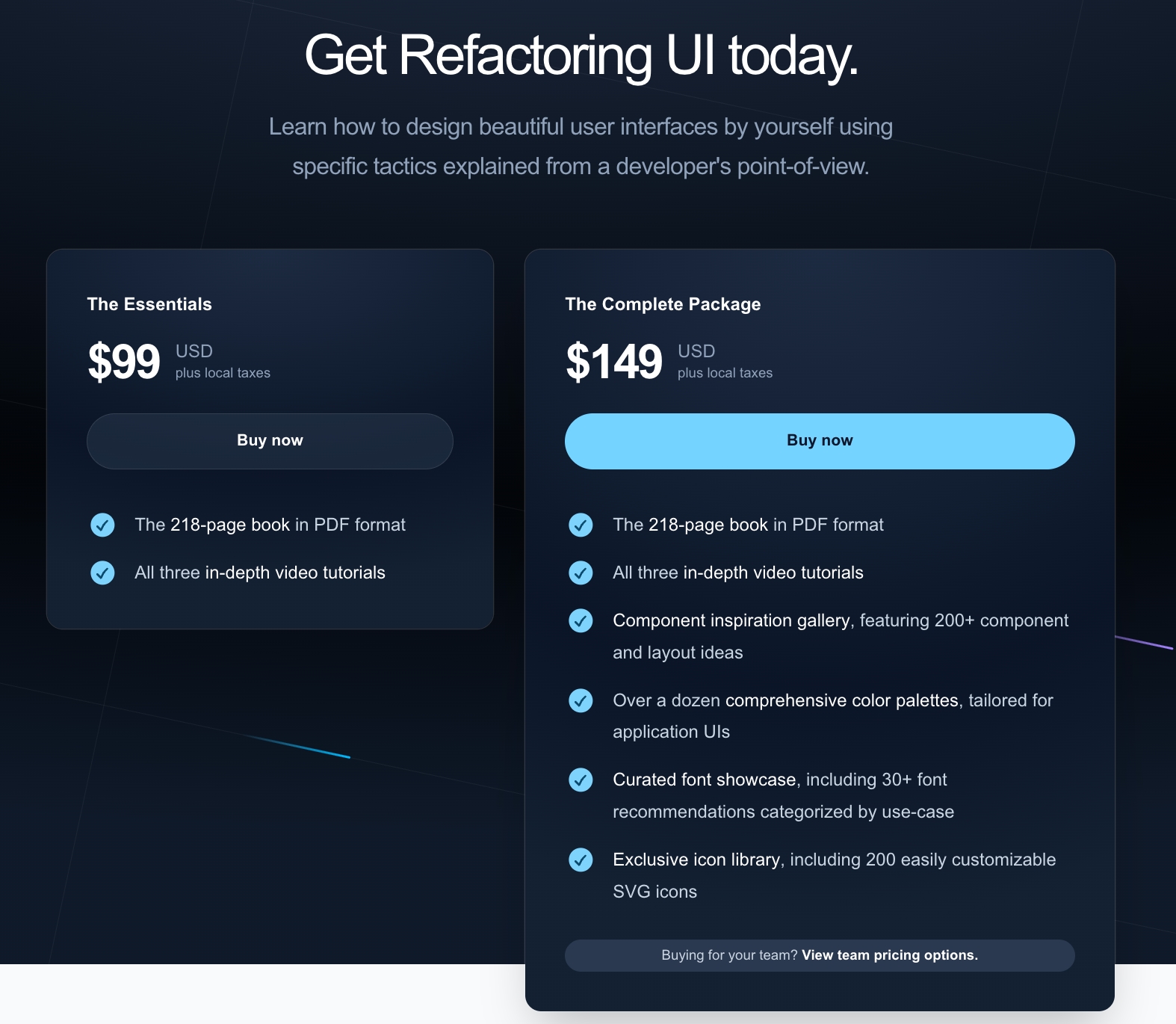
The price difference is only $50. But those extra assets save developers hours of work. A developer thinks, "These components will save me 10 hours. My time is worth more than $5 per hour. The $149 tier pays for itself."
That is the power of utility pricing. Your Pro or VIP tier should always include something that makes implementation faster or easier.
Step 4: Create high-converting bundles
Bundling increases your Average Order Value (AOV) by packaging multiple products together and selling them for a single price, making the overall offer feel more valuable without forcing buyers to make separate decisions.
Bundling only works when you have more than one related product. If you are selling just one course, this strategy is not for you.
This works only if the products are related. The bundle must make logical sense. Do not bundle random products. This confuses the buyer and lowers the perceived value of both courses.
How does bundling work?
Let us look at an example. Course A costs $100. Course B costs $50.
Total value is $150. You sell the bundle for $120.
The customer feels they are saving $30. They are happy. You are happy because you just sold a $50 product that they might not have bought otherwise. You increased the transaction size.
Take SuperHi, a creative coding and design platform, for instance. The platform uses a different bundling system. It does not force a specific bundle on you. It lets you choose.
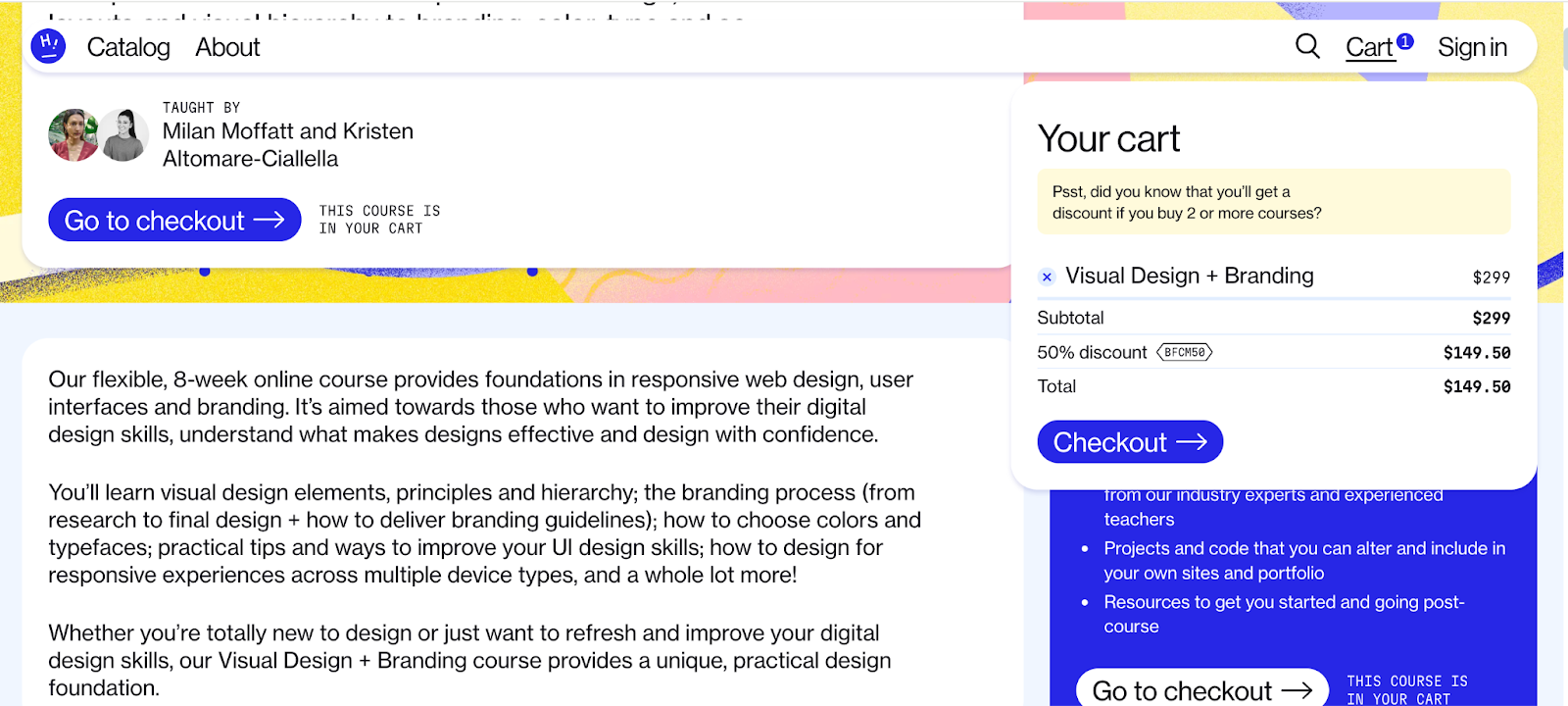
The rule is simple: "Add 2 or more courses to your cart and get 50% off."
Here is the psychology. If a buyer wants one course for $149, they realize that for just a little more, they can get two courses because of the massive discount.
The result? Almost no one buys just one course. The discount forces the user to browse the catalogue for a second item just to unlock the deal.
This strategy works because it gives buyers control while still nudging them toward a larger purchase. They feel smart for maximizing value. You increase your average order without pushing a pre-packaged bundle that might not fit their needs.
💡Pro-tip: If you have a large library of courses, you can offer an "All-Access Pass." The customer pays a high one-time fee to unlock everything. This is attractive to "super fans" who want to consume all your content.
Step 5: Offer discounts strategically (without training buyers to wait)
Discounts are a double-edged sword. They can drive a spike in sales, and also rupture your long-term revenue.
If you run a sale every month, your audience learns a lesson. They learn that your full price is fake. They learn to wait. They will never pay full price again.
Here are some discount tactics you can use:
You must be careful. You need a valid reason for every discount.
Step 6: Test, optimize, and adjust your pricing over time
Your price is not set in stone. You can change it. You should change it.
The market changes. Your expertise grows. The value of your course increases as you add testimonials and case studies.
Start lower, aim higher.
It is okay to start with a lower price for your first launch ("Beta Launch"). You want buyers. You want feedback. You want testimonials.
Once you have social proof, you can raise the price. It is much easier to raise a price than to lower it. Lowering a price later can upset the early buyers. Raising a price rewards the early buyers. They feel smart for getting in early.
Monitor your conversion rates continuously.
You need to track the numbers. Look at your sales page conversion rate. If 10% of visitors are buying, your price might be too low. You are leaving money on the table.
If 0.1% of visitors are buying, your price might be too high. Or perhaps your marketing copy is not justifying the price. A healthy conversion rate depends on the price point. For a $100 course, a 2% to 5% conversion rate is good. For a $1,000 course, a 0.5% to 1% conversion rate is normal.
Lastly, optimize your pricing structure for profit over volume. This brings us to the most important section.
How to Price an Online Course in a Way That Is Fair for Your Customer?
Fair pricing balances the value you provide with that of your audience, which they can comfortably afford. These are the five best practices that effective course developers abide by.
Value-based pricing, not cost-based pricing.
The cost should be based on the change or result your course brings, other than the duration and money you invested in it.
When your course enables buyers to save $1K, gain extra income, or gain a career, charge a fraction of these values. Google can provide the information to buyers who declare that it should be free. Your course has greater structure and solid structures, as well as clear instructions that free material does not offer.
Prove that you have a solid ROI to support your price.
Demonstrate the amount of money that buyers will save, earn or become more efficient. Where possible, ensure the outcomes with an offer of money back. Price is not as much of an objection when your audience can determine the payback of the price in advance before committing to a purchase.
This is precisely the logic behind Alex Hormozi’s $100M Offers framework, often considered the modern playbook for building offers people find difficult to refuse.

One of his strongest levers is the guarantee, which he breaks into four types:
- Unconditional: No-questions-asked refunds that remove all perceived risk.
- Conditional: If the learner follows the process and does not get results, compensation kicks in.
- Anti-guarantee: Explicitly no refunds, used to signal exclusivity and seriousness.
- Implied: Performance-linked pricing or outcome-based commitments.
The takeaway is simple: a strong guarantee does more than reduce friction; it increases perceived value.
If you want your pricing to hold firm, mirror this logic. Tie your price to measurable outcomes, quantify gains, and where appropriate, back results with risk-reversal. ROI sells the value, and ‘Guarantees’ sell the decision.
Design a pricing path and structure it around your strongest offer
An underrated practice for pricing your online course smartly is to structure it instead of underpricing your main course.

For instance, you can use a lower-priced entry offer to remove resistance. Then, position your core course as the real solution. And lastly, reserve premium access for buyers who want speed, depth, or proximity to you. This is how you scale without racing to the bottom on price.
Identify your perfect audience in order to generate demand.
The closer you position yourself to your audience, the greater demand you can make of them have towards your course. Courses with specific audiences and clear target markets have high prices since they address immediate demands.
The greater the demand, the less important the price is.
Demonstrate your skills and expertise to boost course perception.
Credibility will have a direct influence on the amount of money buyers will pay. Publish case studies, testimonials, your story and evidence of results. buyers who purchase courses seek critical information that is offered by someone who is aware of what is important, and they do not waste time searching in vain information that can be found through free materials.
This skill justification enables you to charge above and a notch higher than bargain-level competitors. A strong example is Joanna Wiebe of Copyhackers. Through her programme, Copy School, she commands a premium of over $2,000 per year by consistently demonstrating results, not just teaching theory.
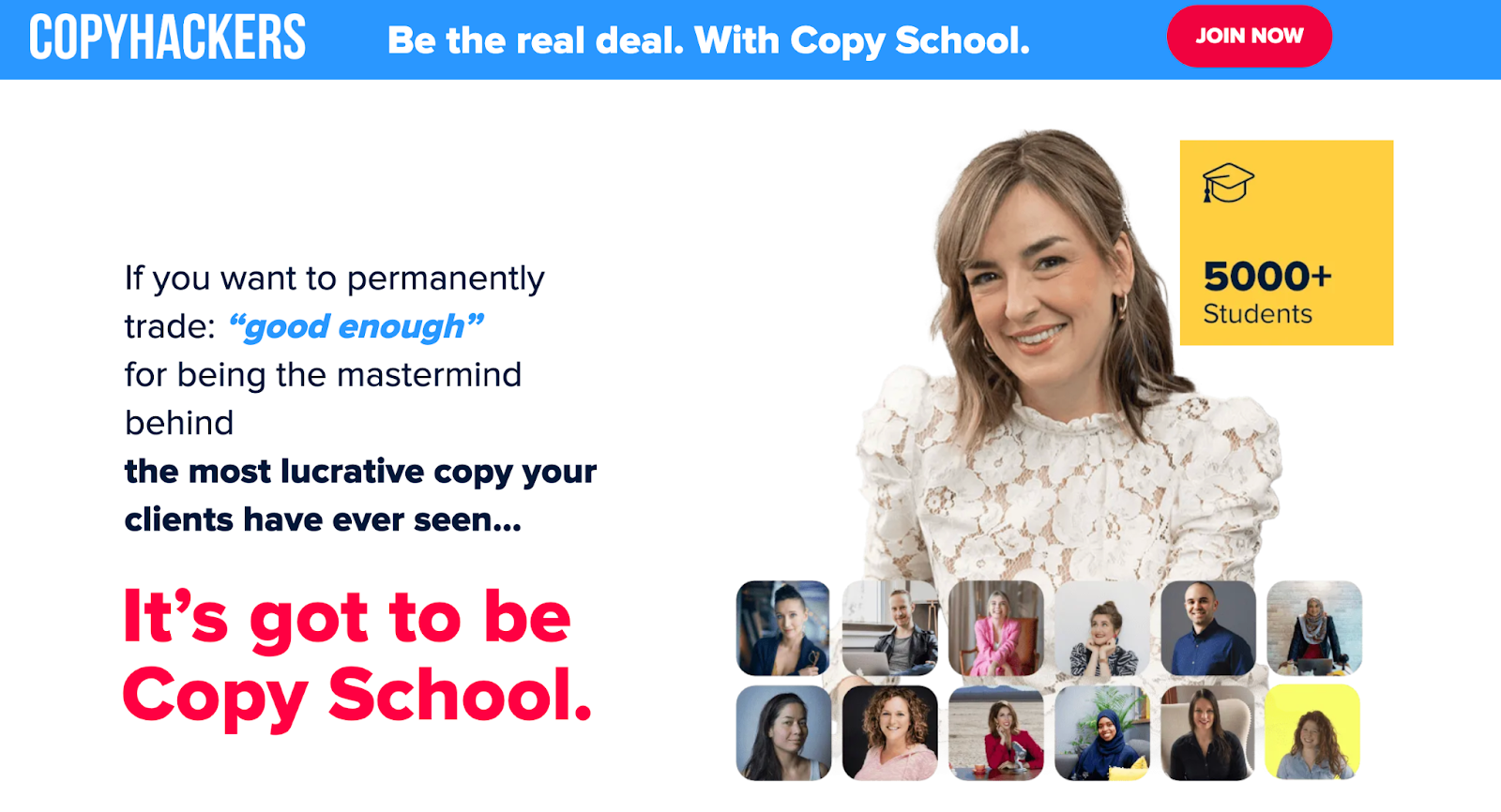
Instead of broad advice, she publishes detailed case studies, such as how a single email generated six figures in revenue, supported by real data and testing insights. This positions her work as applied expertise, not general instruction.
When buyers can see results in action, price resistance drops. That is how demonstrated skill allows you to charge above bargain-level competitors.
Real-World Pricing Examples for Inspiration
Pricing advice sounds good in theory. Seeing how real creators price their courses shows you what actually works.
These four examples cover different niches and business models. Each one reveals a specific pricing strategy you can adapt for your own course.
The impulse buy system (Specific skill focus)
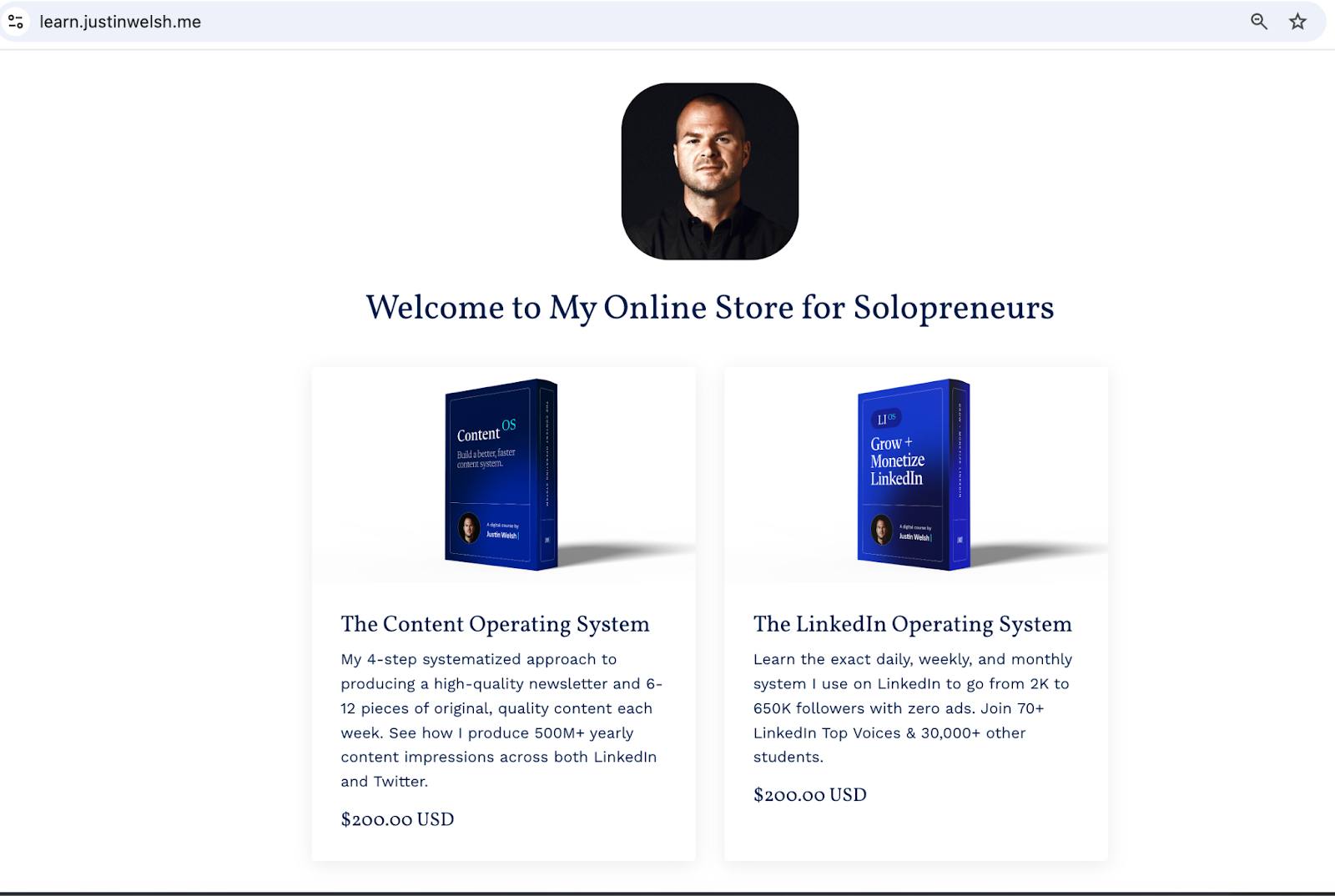
- Creator: Justin Welsh
- Product: The Content Operating System / The LinkedIn Operating System
- Price: $200
Justin Welsh does not sell a $2,000 masterclass. He sells systems that solve one specific pain point, like growing on LinkedIn.
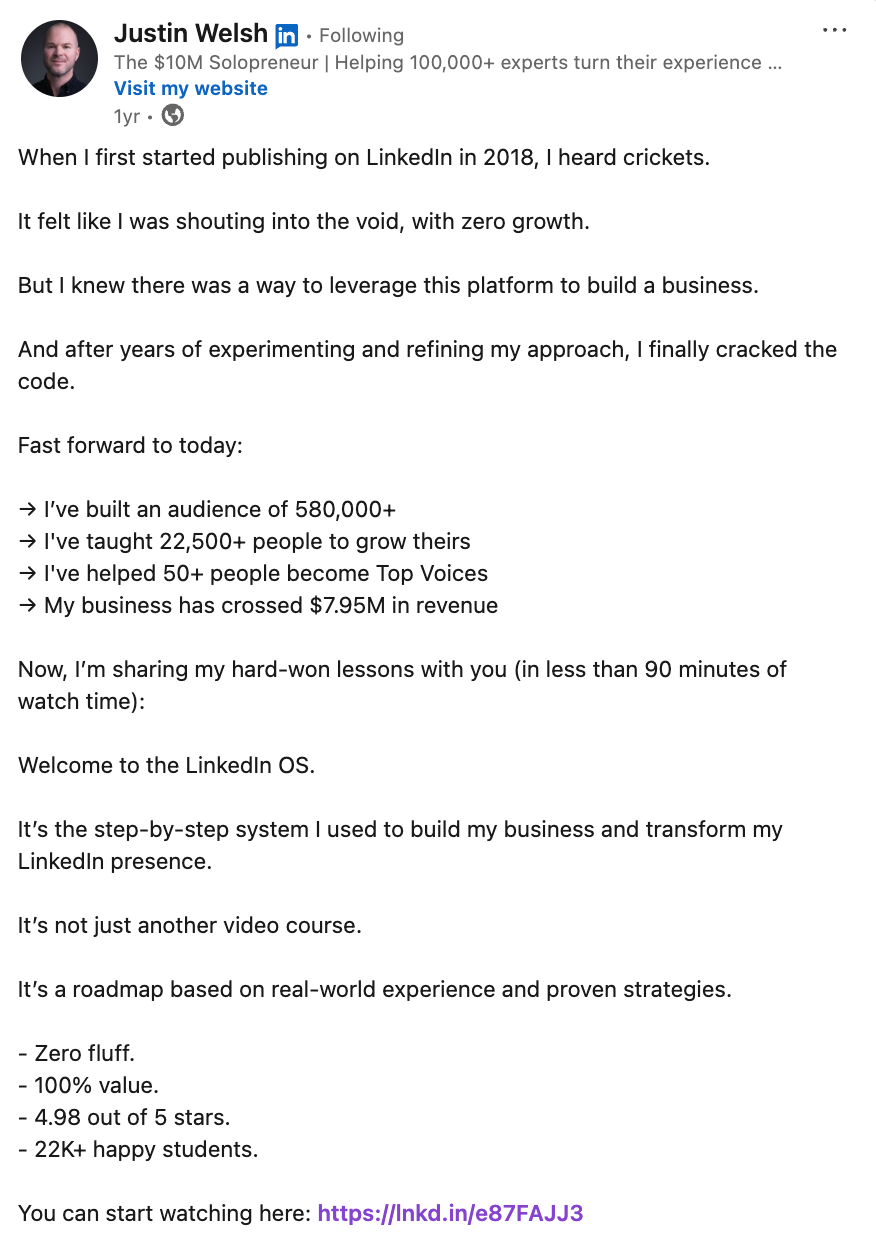
His price sits in the sweet spot for professional development. High enough to signal quality. Low enough that buyers do not need approval from a spouse or boss.
💡Your takeaway: Price-specific, actionable workflows between $97 and $197. This drives volume sales without creating heavy support demands.
The community and convenience model (Wellness)
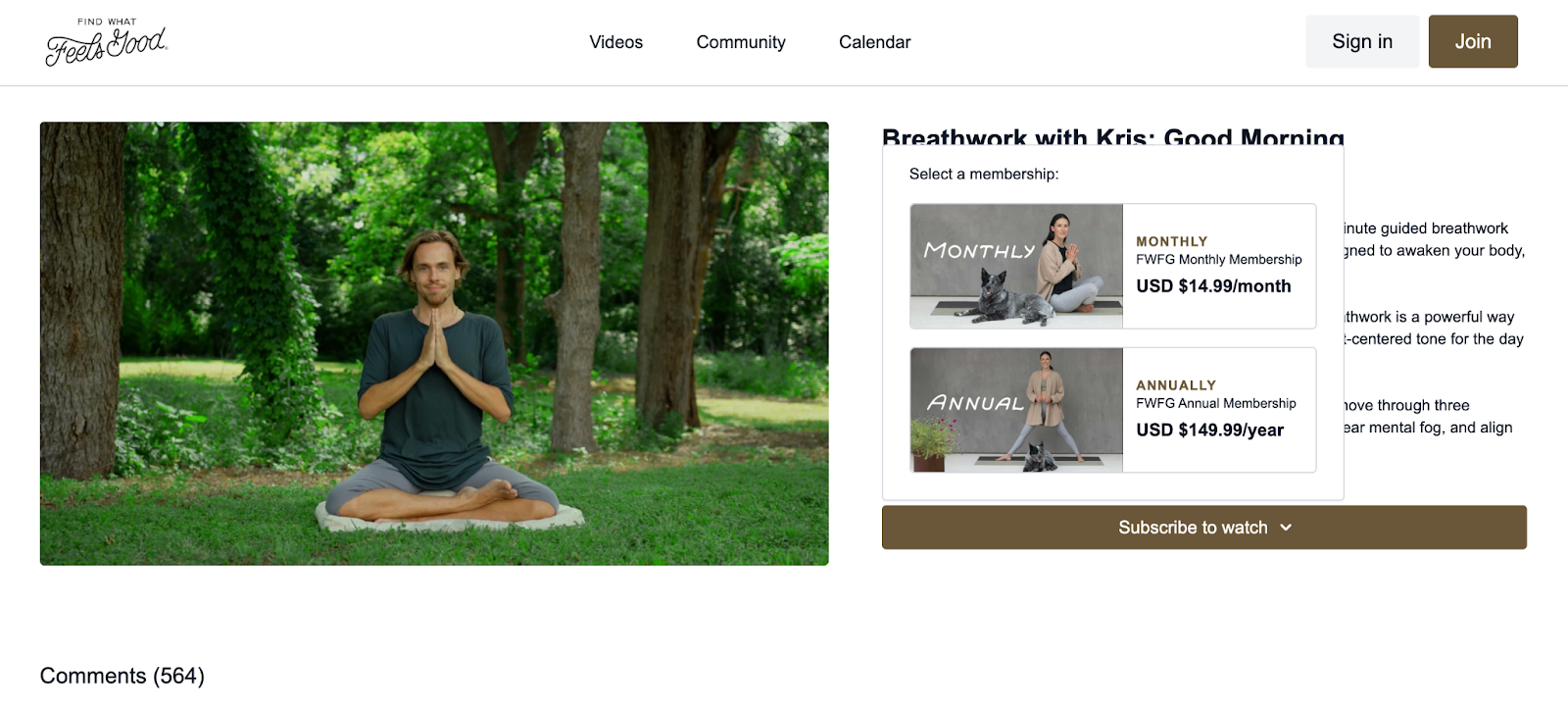
- Creator: Yoga with Adriene (Adriene Mishler)
- Product: Find What Feels Good (FWFG) App
- Price: $14.99/month or $149.99/year
Adriene built 12 million YouTube subscribers by giving away hundreds of free yoga videos. Then she launched a paid app.
The app offers ad-free viewing, offline downloads, and exclusive content. She is not selling yoga instruction. That is free. She sells convenience plus membership in an inner circle.
The price matches a Spotify subscription. Fans barely hesitate.
💡Your takeaway: If you have a large free audience, price membership at $9 to $15 per month. Sell convenience and community, not information.
The thought leader model: B2B newsletter

- Creator: Lenny Rachitsky
- Product: Lenny's Newsletter (Substack)
- Price: $20/month or $200/year
Lenny writes deep-dive product management advice. He shares occasional free posts. The valuable insights live behind a paywall. He targets professionals whose companies often cover the cost.
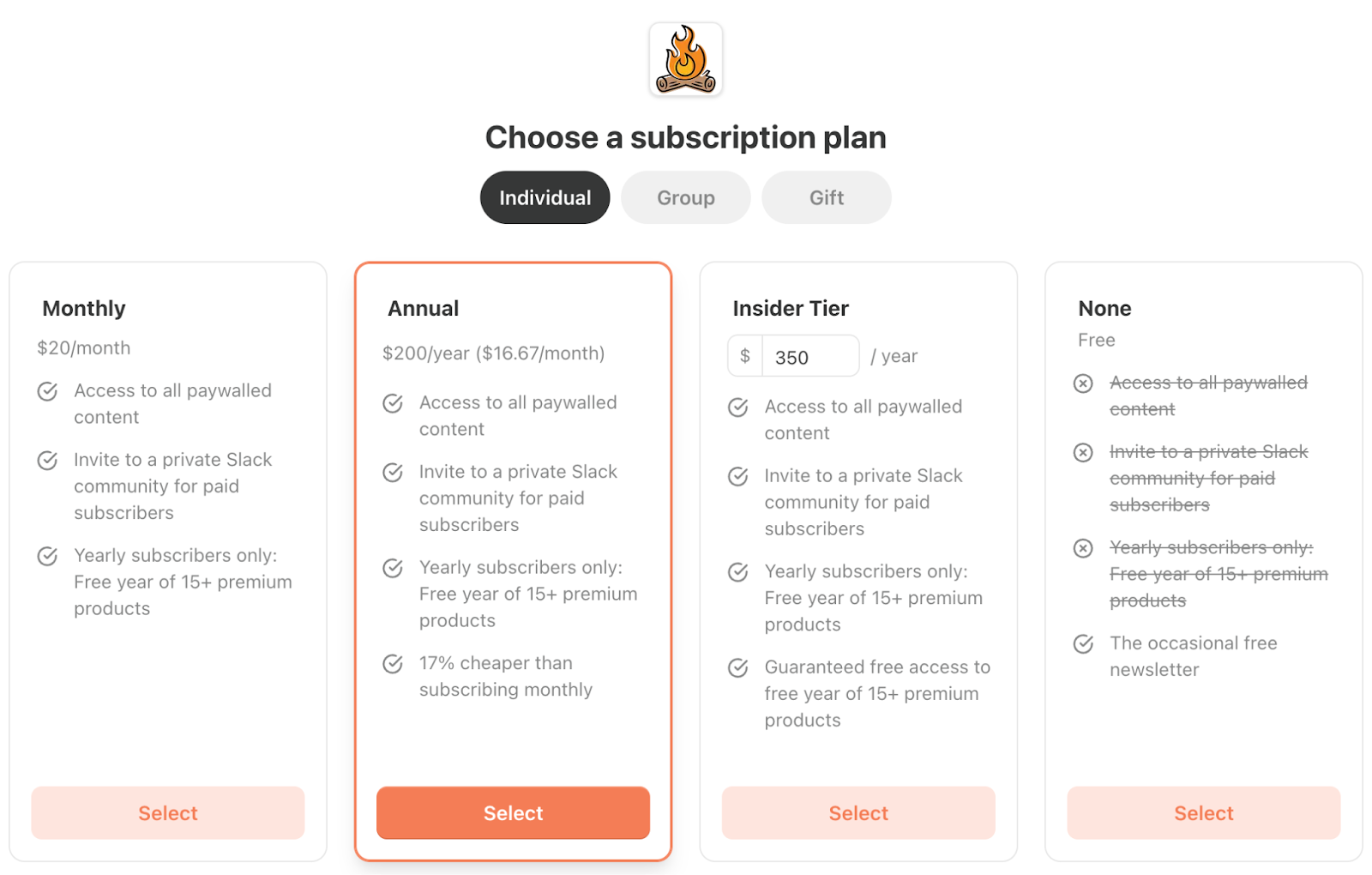
Even without reimbursement, $20 per month costs less than two coffees for career advice that impacts a $150K salary. Over 500,000 people subscribe. Tens of thousands pay.
💡Your takeaway: Professionals will pay $15 to $30 monthly for weekly insights that help them earn more. You do not need a fancy platform. Just help them succeed at their job.
The second brain evolution (Pricing history)
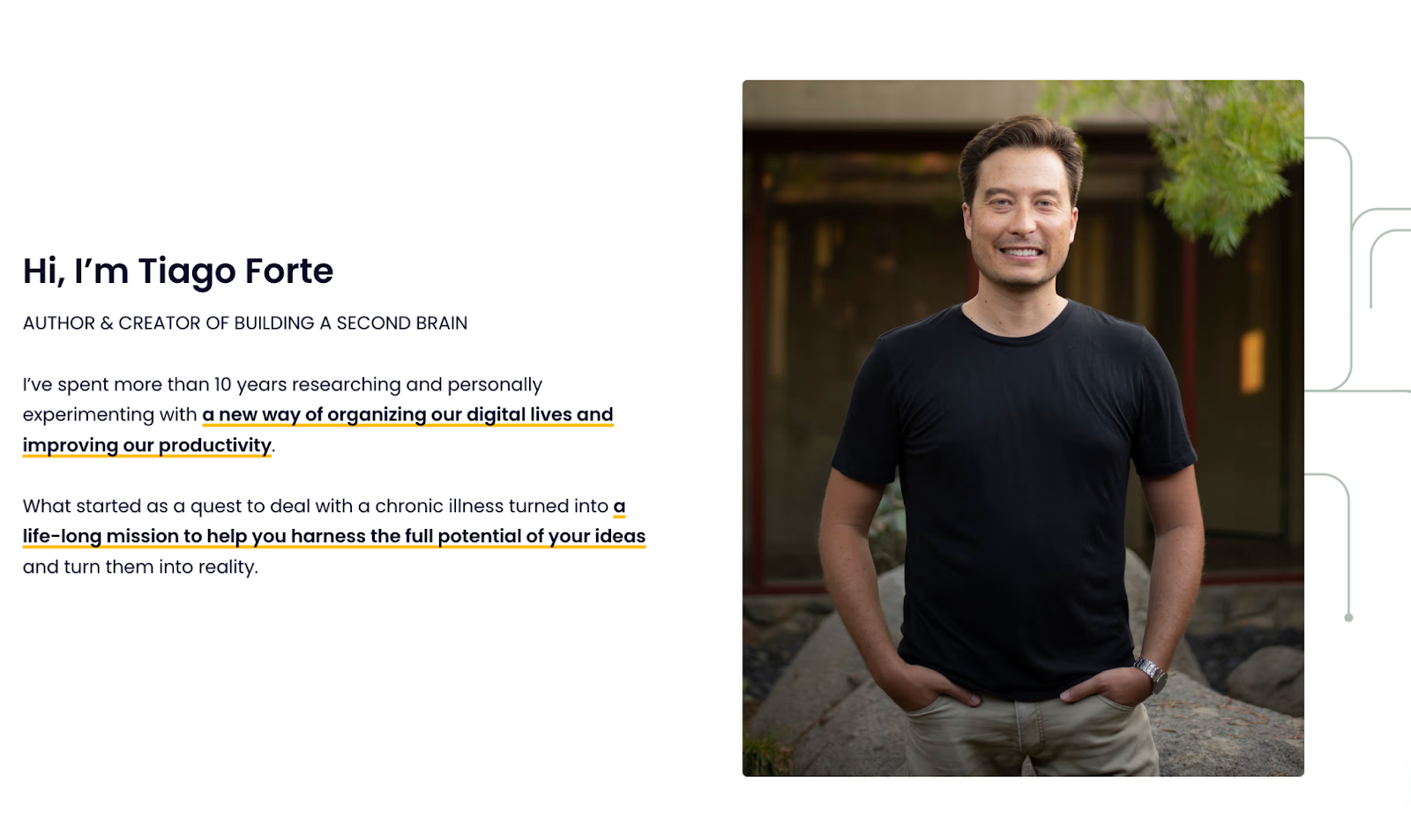
- Creator: Tiago Forte
- Product: Building a Second Brain
- Price Evolution: Early days: ~$499 (Beta testing with live cohorts). Peak popularity: $1,500+ (Live cohort mode). Current: ~$499 (Self-paced version)
Tiago launched with live cohorts to perfect his material. Once the content worked, he filmed it and switched to self-paced delivery at a lower price.
Live cohorts drain energy. Self-paced courses sell to thousands without requiring you to show up daily. He dropped the price but increased profit margins because the product became passive.
💡Your takeaway: Launch live at a premium price to test your content. Then convert it to self-paced at 30-50% of the original price for passive income.
Common Pricing Errors 2026 Creators Must Avoid
When you set your price, you will encounter psychological pitfalls. Recognize them.
In pricing your creations for 2026, be aware of seven common pricing mistakes that will negatively impact your profit margin and your success. The following are psychological traps that you may face when determining your pricing:
Cost-plus pricing
Many creators mistakenly set their pricing according to how many hours they worked on the project. For example, you may say to yourself, "I worked 100 hours on this, therefore I should charge X."
However, the total number of hours you worked has no bearing on how your customers will perceive your service. What matters to them is what problem you solved for them. If you can solve their problem in only 10 minutes, it doesn't matter to them if it took you 5 years to develop the course. In reality, most people are looking for quick answers rather than long-winded courses.
Imposter syndrome discounts
Many creators suffer from imposter syndrome. When you think to yourself, "Who am I to charge this much?" you're probably going to lower your pricing to make yourself feel more comfortable. Unbeknownst to you, you are hurting your buyers by discounting your pricing.
If they pay a "low" price, they will most likely treat the course like a "cheap" product. If they don't value the product, they're going to disregard it. You need to believe in the value of the solution you're offering based on your experience and expertise.
Imitating competitors without understanding their business model
When you see a competitor charging $27, you think, "I have to charge $27 too!"
But you don't know what their business model is - perhaps they are only selling the $27 product to draw in leads for a much higher price on a larger package (possibly up to $5,000).
When you copy them without knowing what their back-end product is, you're going to end up in bankruptcy.
Failing to offer payment plans
If you have a course that costs over $300, you need to offer a payment plan for it. The majority of people live from paycheck to paycheck and can easily afford up to $100 each month, but do not have $300 available on hand at one time.
You may charge more for the payment plan than if they paid for the course in full, since a payment plan incurs additional administrative responsibility and costs.
For example, if the course is $300, you may offer a payment plan consisting of 4 ($85 each) monthly installments for a total of $340.
Complicating the offer
Concerning presenting your offer, avoid overwhelming the customer with ten different packages. Coming up with Gold, Silver, Bronze, Platinum and Diamond options is essentially Analysis Paralysis, and can cause someone to freeze up and say no.
Consider offering just one price, or a maximum of three tiers, to cut down the amount of decision-making that the customer needs to do, and make it easier for them to go with what you're offering.
Tune Your Pricing Strategy Into A Working System With FreshLearn
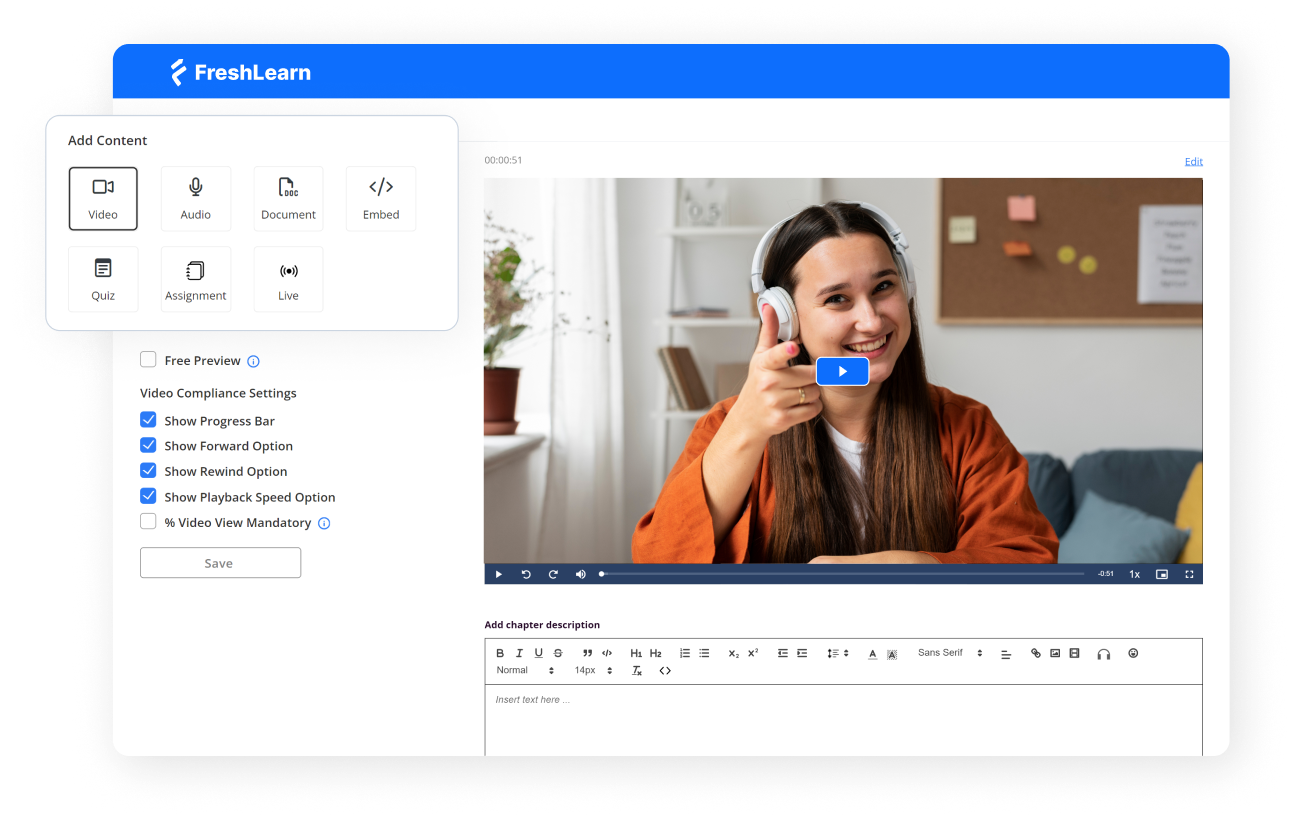
Once you have your pricing strategy all planned out, you’ll need a platform that lets you put it into practice without struggling with tech or losing your margins to hidden fees.
FreshLearn sits in that sweet spot.
FreshLearn is an all-in-one creator platform where you can host courses, live cohorts, workshops, communities, and digital downloads, while keeping tight control over how you charge for each offer.
FreshLearn is built around the same principles you have seen so far in this guide. It supports one-time offers, memberships, payment plans and bundles, so you can design a pricing path your way.
FreshLearn’s pricing is designed for creators

FreshLearn uses a freemium model with a clear tier of paid plans. At the moment, the structure looks like this.
As we’ve discussed, FreshLearn offers value-based pricing.
That means once you pay for your plan, your revenue is limited only by your marketing and the price you choose, not by a percentage cut that grows with your success
FreshLearn offers flexible pricing options

FreshLearn’s strongest link to your pricing strategy lies in its payment flexibility. The platform lets you offer
- One time payments for stand-alone courses, workshops, templates, or digital downloads
- Recurring subscriptions for memberships, communities, or content libraries, with monthly or yearly billing
- Multipay and installment plans, so a higher ticket program can be split into two or more payments
- Product bundles that combine related courses or resources into a higher value package
- Coupons and advanced discounts that support launch offers, early bird deals, or loyalty rewards
- Referral and affiliate-style programs that reward students or partners who bring in new buyers
For example, you can run your main course at a core price, then add a three-payment installment option for buyers with lower cash flow.
You can then bundle that same course with a live cohort or community on the No Brainer plan, and price the bundle higher for students who want support and accountability.
The platform keeps all those offers connected to the same underlying content. This makes testing far easier than cloning entire courses just to try a new price.
FreshLearn makes it easy to get money into your bank account
On the payment processing side, FreshLearn integrates directly with Stripe, PayPal, and Razorpay, and also allows additional gateways through APIs or Zapier.

Once you connect your payment gateway, member payments go directly into your own Stripe, PayPal, or Razorpay accounts. FreshLearn does not sit in the middle as a merchant of record

Through Stripe and the platform’s payment features, you can also collect EU VAT, US sales tax, and other regional taxes, and access detailed reports for your accountant. Higher plans add automatic tax collection and more advanced checkout customization.
Moreover, learners receive receipts and can log into a dedicated member area to see past payments, download invoices, and manage card details.

Because FreshLearn takes 0% platform commission on paid plans, the only ongoing costs against your revenue are your chosen plan fee and standard gateway charges.
For creators who plan to run higher ticket offers or long-term memberships, this can beat percentage-based platforms quite quickly once sales volume grows.
FreshLearn Supports the Pricing Path You Design
Pricing is not something you crack on the first go, and that’s fine.
You plan, test, analyze, tweak, and repeat until you find the sweet spot that feels right in your gut and works in your numbers. The goal is progress, not perfection.
The big step is choosing a number and putting yourself out there. Nothing matters until a real price meets a real person.
That is where a platform like FreshLearn helps you move from theory into action.
You can set a price, try a payment plan, test a bundle, or run a limited-time offer, then watch what students do and adjust fast.
You can focus on refining the offer itself while FreshLearn handles the checkout, payment options, and payouts in the background.
2026 is wide open for creators who are ready to take a chance. Don’t let a number hold you back.

You might also like
- How To Become A Successful Online Course Creator?
- How To Write a Good Course Title (Guide + Examples)
- Everything You Need to Know About Creating an Online Course
- How To Name An Online Course + 10 Ideas To Stand Out
- Best Practices to Follow While Creating Online Courses
- How to Create a DIY Home Video Setup for Online Courses!


